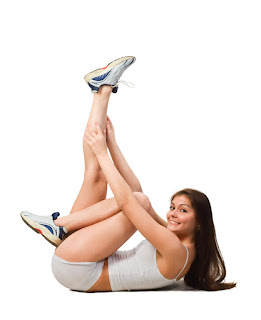Warm Up :
Don't just go into stretching cold, you could hurt yourself and be out of commission for a while. Start your workout with a light run, jog or walk; something that will get your blood pumping and get oxygen moving into your muscles.
Heat helps your body's range of motion and allows it to stretch easier. Think warm Silly Putty vs. cold Silly Putty. To get the heat, either use a heat pack on your muscles or try sitting in a sauna or hot tub prior to exercising.
Ballistic Stretches :
Ballistic stretches more or less shoot oxygen into your muscles by way of movement and gravity. The more oxygen in your muscles, the more they'll be able to move. Start by swinging your legs and arms (independently of course) in small circles or back and forth. DO NOT OVERDO IT; too much ballistic stretching can lead to injury
Passive Stretches :
Passive stretches are your most common form or stretching. This involves using one body part as leverage against another to facilitate the stretch. Hamstring, quad and calf stretches are great and easy to maneuver; you can also get some good glute and spine stretches though several seated exercises. Basically any muscle group can be worked with these stretches and should be the bulk of your workout.
Discomfort, Not Pain :
Make sure when you're engaging in your passive stretches that you're pushing yourself to the point of discomfort and not to the point of pain. Slowly bring yourself to your limit and know when it is. You will find this limit getting progressively further as you keep stretching in the coming weeks.
Holding :
Make sure you're holding your poses for the right amount of time. That's about 15-30 seconds for passive stretching and about 8-10 seconds for active stretching.
Active Stretching :
Active stretching requires that you use your muscle strength to perform the stretch. This refers to stretching programs like yoga and some pilates. Active stretching can be the most difficult form of stretching but it's where you'll likely see the best returns and advancements.
Repetition:
Don't just stretch one time once a week. The more you stretch the more flexible you'll become. When stretching try to perform at least 2 sets each of your stretches—this largely won't apply to active stretching—and try to stretch at least 3 times a week.
Weight Lifting :
Flexibility is about muscle endurance and the best way to increase endurance is by overloading your muscles (Fitday.com). This doesn't mean you have to max out with large weights; in fact, smaller weights at higher repetitions will work much better for developing flexibility.
Recovery :
Muscles need to recover just like a boxer after a title match—which is what your muscles have been doing, fighting. Give your muscles time and proper rest in between exercising. It will mitigate damage and make your muscles more prepared and ready when you next exercise.
With these 10 steps you should be well on your way to quickly, effectively and safely increasing your flexibility.

No comments:
Post a Comment